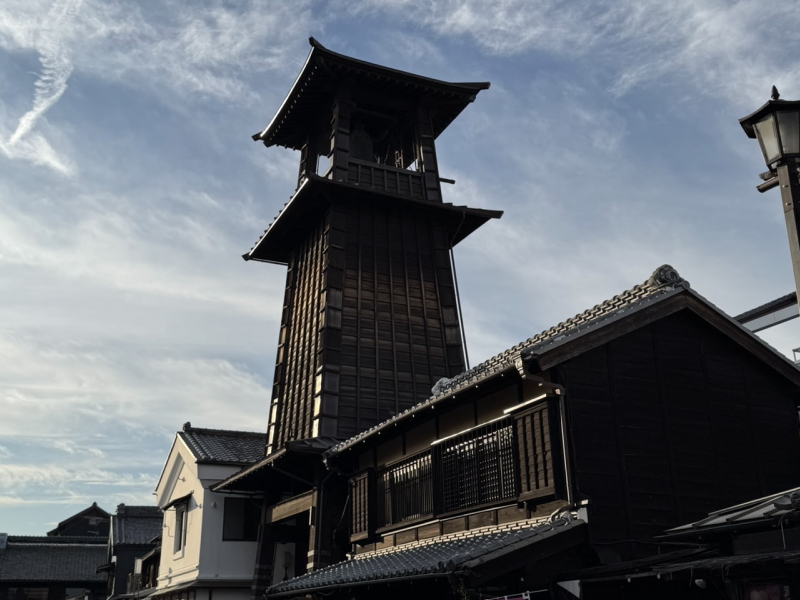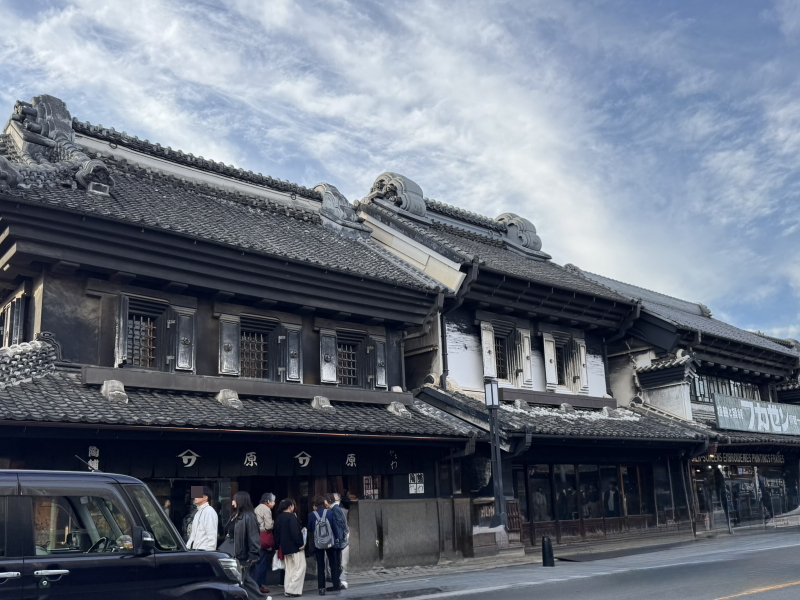Why was this streetscape formed in this location? Urban structure and location conditions
Kawagoe’s iconic “Toki no Kane” (Time Bell) and storehouse-style streets
When you think of Kawagoe, the first thing that comes to mind is its stately black-painted storehouse buildings and the “Toki no Kane” (Time Bell), which continues to chime the time. This streetscape, which retains a vestige of old Japan, was not developed simply for tourism; rather, it is a “living cultural heritage” that has been preserved through centuries of history and the accumulated efforts of local people.

The kura-zukuri streetscape that captivates visitors is not the product of chance. It is the result of a complex interplay of various factors, including geographical conditions, economic development, and lessons learned from disasters, which has shaped the current landscape.

Roots and Urban Structure as a Castle Town
The origins of Kawagoe’s townscape date back to the late Muromachi period through the Sengoku period, when father and son Ota Dokan and Michizane built Kawagoe Castle. This led to Kawagoe’s development as a key political, military, and economic center in Musashi Province.
During the Edo period, Kawagoe Domain came to be valued as the Tokugawa Shogunate’s northern defense, and urban planning as a castle town began in earnest. Areas for samurai, merchants, and temples and shrines were clearly zoned around the castle, and an orderly town layout was developed. In particular, the current Kurazukuri area flourished as a merchant town, becoming an important commercial hub supporting trade with Edo.
In this way, Kawagoe developed a unique urban structure as a “castle town where defense and commerce coexist,” and its name spread throughout the country.
Prosperity Born from Location and Topography
Kawagoe City is located on the eastern edge of the Musashino Plateau, on a gently sloping land. This topography offers the advantage of relatively low flood risk and minimal earthquake damage. It also boasts excellent transportation and logistics access, thanks to the nearby Shingashi River and the Kawagoe Kaido highway connecting Edo and Kawagoe.
As shipping along the Shingashi River, which transported goods from Edo, became popular, Kawagoe quickly established itself as a commercial city. Economic and cultural ties with Edo strengthened, and the city flourished to the point that it was nicknamed “Little Edo.” Inns and merchant houses lined the road, and eventually this led to the current streetscape of storehouses.
The Great Kawagoe Fire and the Birth of Kura-zukuri Architecture
the Great Kawagoe Fire of 1893 (Meiji 26) was a major catalyst for the formation of the kura-zukuri streetscape seen today. At the time, Kawagoe was densely packed with wooden houses, and as the fire spread, much of the city was destroyed. The famous “Toki no Kane” (Bell of Time) and the famous temple “Renkei-ji” were also lost in the fire.
However, this fire triggered a resurgence in the popularity of the “earthen storehouse” style, which had long been used in some areas, and merchant houses with excellent fire-resistant storehouses began to be built one after another. Storehouse buildings are designed to prevent the spread of fire by thickly plastering the walls with clay and using tiles on the roof. The construction costs were enormous at the time, said to be more than 10,000 yen per house (equivalent to tens of millions of yen today).
The storehouse-style streets that were built in this way have become a symbolic landscape of Kawagoe that remains to this day, and the wisdom learned from the disaster has been passed down to this day. The oldest known building, the the Osawa family home (built in 1792), is designated as an Important Cultural Property of Japan.
A city’s unique character shaped by its rich history
Kawagoe’s kura-zukuri streetscape is a crystallization of history, born from the interplay of diverse factors, including urban structure, location, and disaster prevention wisdom. More than just a retro tourist destination, it embodies the efforts and ingenuity of generations of people, including their lifestyles, commerce, faith, and disaster preparedness.
Visitors can walk along the cobblestone streets that have accumulated over 400 years of history while listening to the sound of the Time Bell. If you stop and look up, you will see the storehouse roofs and lattice windows that bear witness to the skill and pride of the craftsmen of the time.
The streets of Kawagoe are not just a tourist attraction, but can also be considered a living textbook of urban history. The next time you visit, be sure to think about the layers of history hidden within the buildings.
Landscape Preservation Initiatives Passed Down to the Present
In recent years, Kawagoe City and local residents have been actively engaged in landscape preservation efforts. Efforts to harmonize tourism and daily life are underway, including undergrounding utility poles, standardizing sign designs, and supporting the restoration of tiled roofs. Additionally, young architects and artisans are opening stores that combine traditional storehouse architecture with modern touches, creating a townscape where the old and the new coexist.
It is these community-wide efforts that continue to support Kawagoe as a city that evolves while preserving its history.
The Bell Tower of Time and the storehouse-style streets are symbols of Kawagoe, and they also tell the story of the city’s development and the history of its people’s lives. Natural conditions, topography, fires, and human ingenuity all combine to create an “inevitable landscape” that has shaped Kawagoe today.
As you walk around at your own pace, take a look at the story behind how the city came to be what it is today. You’ll surely be able to experience something deeply moving that you can’t get from sightseeing alone.


